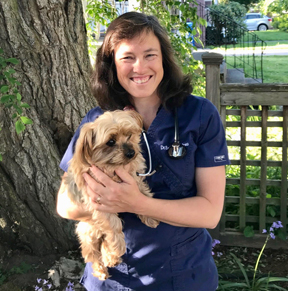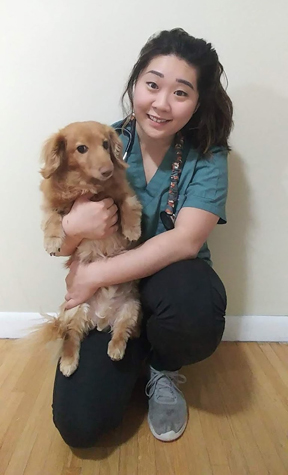
Davidow bug

For each of the past three years, the VIN Foundation has organized an essay contest for veterinary students called Solutions for the Profession, giving prizes of $3,000, $1,500 and $1,000 to the top three writers. The purpose is to encourage students to think about issues facing the veterinary profession and then to use these fresh perspectives to encourage innovative approaches to our industry's challenges.
The foundation is the charitable arm of the Veterinary Information Network, an online community for the profession and parent of the VIN News Service. The writing competition is part of the foundation's mission of providing tools and resources to support veterinary students and veterinarians through their careers. Previous years' winners and their essays can be viewed here.
This year, students were asked to share their thoughts on consolidation in the veterinary profession. The formation of larger groups of veterinary hospitals started in the 1980s with Banfield and VCA. There are now more than 30 large groups, half of which have formed in just the past five years. A single family company, Mars Inc., through its ownership of VCA, Banfield, BluePearl and Pet Partners, now owns more than 2,000 veterinary clinics in the United States. It has been predicted that 25% of all veterinary hospitals, representing close to 50% of veterinary visits, will be owned by corporate groups by 2023.

Photo by Mike Ford
Dr. Beth Davidow with her dog, Biscuit.
The essay contest focusing on consolidation drew 80 entries. As one of 10 judges, I was so impressed with the thoughts, ideas and writing styles of the essayists that I wanted to publicize their efforts by highlighting the top-rated competitors through my blog, The Veterinary Idealist and this commentary.
The winners and finalists are five women and one man from the U.S., Canada and Australia. They come from a variety of backgrounds, are in different stages of their schooling, and each is considering a different career path in the veterinary field.
I spoke to the students about the inspirations and thoughts behind their essays and about their hopes for the future of our profession. Today and during the next two weeks, I hope you'll enjoy meeting them, reading their essays and hearing their perspectives.
Joanne Yi, a rising third-year veterinary student at the University of Calgary in Canada, is this year's first-place winner. Joanne learned about the writing competition from a scholarship website. At the time she found the contest, her mom was caring for her grandmother, and Joanne hoped that by winning a prize, she could help her family financially. Her entry also served as a tribute to her mom.
When Joanne was growing up, her mom owned and ran a convenience store. It was successful for many years. Then, a large chain convenience store opened in town. Its prices were lower and its offerings were greater. After a year, Joanne's mom made the hard decision to close her store. In Joanne's town, there was not room for both.
In her essay, Joanne compares what happened to her mom's store with what's happening in veterinary medicine and wonders: “Is this another big fish eats little fish tale? I am hopeful there is another ending to this story than the one my mother and I experienced many years ago. There is a place for both independent and corporate practices to not just live in the same ocean but also thrive together in it.”
Joanna Yi 288

Photo by Joanne Yi
Joanne Yi, pictured with her dog, Teddy, wrote about her mom's independent convenience store. The store, in Riverside, a small community in Ontario, Canada, was successful until a large chain arrived and drew away customers with its "wall-to-wall Slurpee machines and shelves full of magazines."
Joanne's hopes for our industry come from her appreciation of her mom's small store and from her own work experience. Joanne's first job in the veterinary industry was with a "big fish." Before starting veterinary school, Joanne worked at a large VCA-owned ER and multi-specialty practice.
Joanne told me, “Working in a very large practice, there were challenges with employee turnover, pay, and also disagreements over management decisions. However, I always felt that the medical team was committed to top-notch care.” Joanne realizes that the facilities and equipment would be hard to sustain by a smaller group.
This summer, Joanne decided to work for a "little fish." She is employed as an assistant in a small independent practice. Her experience there has shown her the value brought to the community by having an invested veterinarian who has been in the same place for 22 years. Joanne has seen that the bonds built with families over the lifetime of not just one pet, but several, is different on that time scale. The relationships with clients are deeper, richer and stronger.
I asked Joanne if she thought that the contrasts are more related to innate differences in client relationships in primary and specialty care, no matter the ownership structure. She feels that the difference is less about the type of medical practice and more about the stability of the veterinarian over time in their community. While there are no studies on turnover of different types of veterinary practices, if you own the practice, you are tied to it in a very different way than if you are an employee.
The struggle is how to make sure the equipment and large scale needed for certain types of state-of-the-art veterinary medicine and the personal, tight, long-term relationships for primary care both continue to exist in the industry. Is the newest generation of veterinarians with their six-figure student debt loads willing and able to step into the challenges and hours of leadership and ownership?
Joanne worries that her generation may not step in and buy the practices of retiring baby boomer veterinarians. She believes that the debt load and the desire to have adequate family time are both deterrents. When Joanne thinks about her mom and her store, she remembers the really long hours she worked and the challenges. However, she also remembers enjoying going to her mom's store, her mom's pride of ownership and the flexibility it provided.
Joanne is unsure what direction her own career path will take. She knows that she loves surgery but doesn't know if her eventual path will be with a small or large hospital. She hopes that both corporate and independent practices will continue to find success.
Talking with Joanne made me even more convinced of three things:
The first is that veterinarians need to be taking an active role in finding solutions to the student debt problem. I applaud the VIN Foundation for the role it is taking — it operates an online student debt center with a variety of resources — but we need to be even more active in advocating at a legislative level for change.
Second, successful women veterinary practice owners need to speak up and show younger female veterinarians the options they have discovered for raising a family successfully and owning your own business. You can be a great veterinarian, a successful business woman and a great mom (although sometimes not always on the same day).
Finally, I think Joanne has it exactly right in the last line of her essay:
“In either structure, veterinarians remain the sole provider of veterinary services and must maintain professional autonomy to uphold leadership and decision-making roles for the future. ... Veterinary practices, both privately owned and consolidated, must understand and appreciate that our primary obligation is to practice quality medicine in the face of compassion for animals and clients.”
Next: Two essayists approached the topic with different tactics — one with humor, the other with research.
About the author: Beth Davidow, DVM, DACVECC, has been a VIN emergency medicine consultant since 2003 and is also a member of the VIN Board of Directors. She co-owned two 24/7 multi-specialty hospitals in Seattle, and was the first director of patient quality for BluePearl. Davidow currently is vice president of the American College of Veterinary Emergency and Critical Care, and lectures and consults on veterinary critical care, patient safety, and ownership issues. She writes the blog The Veterinary Idealist.